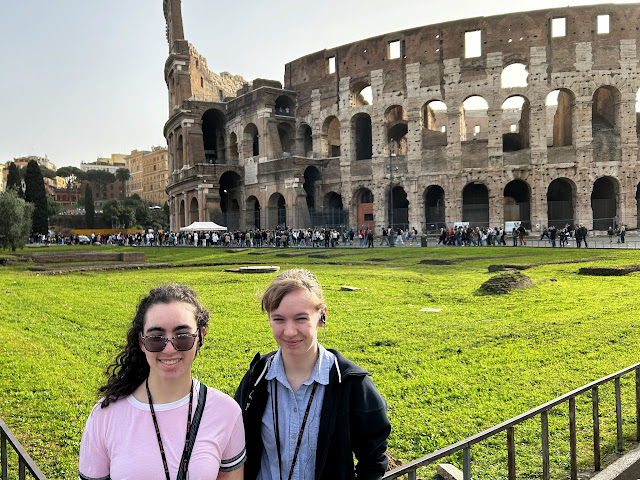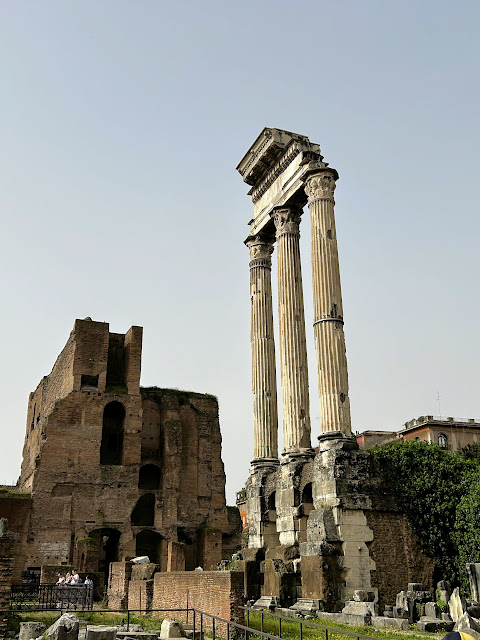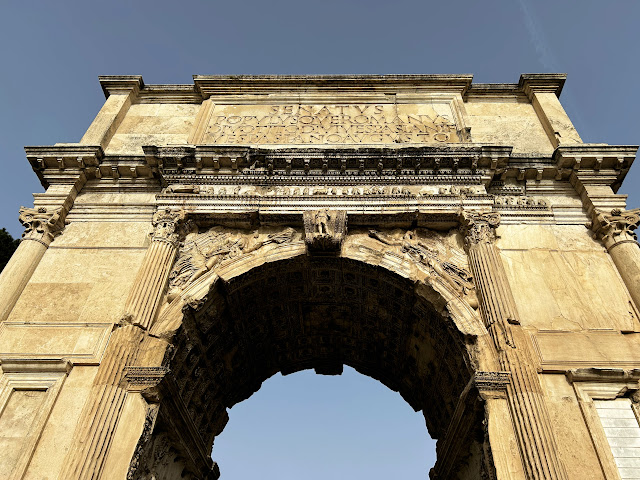Sunday, March 31, 2024: Welcome to Rome!
It was not my first visit to Rome. In December 2011, I gave an invited talk at a scientific conference there, garbed in a borrowed suit owing to an airline baggage kerfuffle. (Danke an meinen Freud, Thomas!) Although I visited many beautiful sites including Vatican City and the Trevi Fountain during that trip, I did not manage to reach the Colosseum. I was very excited to rectify that oversight in 2024 during the HYSO tour.
As an aviator, the first thing I noticed about Rome was the air quality. Peering through a porthole in the side of our British Airways flying Greyhound, I was immediately struck by poor visibility beneath the clouds. Depending on the observer's position relative to the sun, the sky assumed an ochre cast reminiscent of mornings in Rochester during the epidemic of Canadian wildfires that polluted the air in 2023. Most sources indicate that Rome's air quality issues are largely self-inflicted from vehicular and industrial emissions. Even using digital filters to remove haze from the images, the poor air quality is nonetheless evident in many of my photos from Rome.
Monday, April 1, 2024: Back in Time
Rome is a striking amalgamation of modern city, tourist destination, and active archaeological site. While many ancient structures within the modern city are thronged with tourists, signs of continuous excavation and restoration are everywhere.
An ongoing theme throughout our travels in Italy was the reuse of building materials over the centuries. For example, marble from a tumbled-down ancient Roman temple might be found facing a newer Christian house of worship. Our tour guide attributed the longevity of ancient Roman structures to the Roman invention of concrete and the precise use of kiln-dried bricks to fabricate robust structures. In some cases, the brickwork would have been solely used as structural elements hidden behind more elegant marble facades.
Amphitheatrum Flavium
Our first peek of ancient Rome came by way of the Colosseum. Though our tour of the iconic ruin was scheduled later that morning, everyone was drawn to the structure even as our tour guide tried to usher us beyond it.
 |
| The Bear and Kristy get their first look at the Colosseum. |
 |
| Restoration is still ongoing. |
Arch of Constantine
The Arch of Constantine is set between the Colosseum and the Palatine Hill. It was dedicated in the year 315 in honor of Emperor Constantine's defeat of his predecessor, Emperor Marcus Aurelius Valerius Maxentius. At 69 feet tall, it is the largest triumphal arch in Rome. The arch spans the Via Triumphalis, the road on which returning victorious armies would enter Rome.
 |
| See what I mean about the air quality? This was taken looking directly at the sun. |
 |
| We were definitely not in New York anymore. |
 |
| Kristy at the Colosseum. |
 |
| Izzy and The Bear at the Colosseum. |
 |
| Best photobomb ever! |
The Palatine Hill
(Sounds kinda Sithy)
Of the famed Seven Hills of Rome, the Palantine is the most central and has served as a nexus of civilization as far back as the 10th century BCE. Eventually, it became the location of Rome's imperial palaces. (Etymologically, "palatine" is the root of our modern word for palace.)
We trekked upward on an ancient Roman road toward the Arch of Titus to reach the Palatine Hill.
Our tour guide (holding the yellow banner) paused to explain the purpose of the arch to our group.
The top of the arch is inscribed with:
SENATVS
POPVLVSQVE·ROMANVS
DIVO·TITO·DIVI·VESPASIANI·F
VESPASIANO·AVGVSTO
This translates to: "The Senate and the Roman people (dedicate this) to the deified Titus Vespasian Augustus, son of the deified Vespasian."
The Arch of Titus is so prototypical of these kinds of honorific arches that it was the model for the French Arc de Triomphe. However, Paris' version aggrandizes the building of a nation rather than the destruction of one.
What did Vespasian and Titus do that was supposedly so great? It was not building the Colosseum, though they were responsible for that, too. Rather, it was in celebration of the destruction of Jerusalem in 70 CE as prosecuted by that Roman father and son "dream team". While the Arc de Triomphe may have used this landmark as its physical model, it is clear that the nature of events perceived to merit such triumphal arches changed significantly over the intervening 18 centuries.
A panel in the southern support depicts sacred objects taken by Romans from the Temple in Jerusalem, including a very prominent menorah. It is a powerful image that has come to symbolize the Jewish diaspora. Wealth stolen from Jerusalem funded construction of the Colosseum and it is believed that captured Jewish slave labor was used to bring the amphitheater to fruition.
A panel in the opposite upright depicts Titus being crowned with a laurel wreath by Winged Victory (Nike).
Oh, that smart aleck Bear... I have no idea where she gets it from.
From the Arch of Titus, we set our sights farther up the hill to the (literally) palatial ruins there.
Our uphill walk was on a genuine, surviving Roman road. One has to appreciate ancient Roman engineers. This road has survived for centuries while my 2007 paver patio at home is already falling apart despite having been marched on by far fewer armies.
The view from the Palatine Hill is expansive and reveals facets of ancient Rome surrounded by the modern city.
One of the most prominent ruins visible from the hill and the largest structure on the Roman Forum is the Basilica of Maxentius. Construction began in 308 CE under the direction of Emperor Maxentius and was finished in 312 CE by his successor Constantine (the other "arch guy" from earlier in this post).
Farnese Gardens
Built directly on ruins of the imperial palace (Domus Tiberiana) occupied by such Roman luminaries as Tiberius (hence the name), Caligula, Claudius, and even Nero (until he built the Domus Aurea or "Golden House") are the Farnese Gardens constructed in 1550 by Cardinal Alessandro Farnese. It just goes to show that fame is fleeting and, eventually, somebody will use your grand works as the foundation of their own creation.
The Farnese Gardens were the first privately held botanical gardens to exist in Europe. Gathering archaeological understanding of the palatial ruins below is inhibited by the presence of the gardens because no one wants to disturb them.
Orange trees! Our tour guide noted that, if sampled, these oranges would be quite bitter to the modern palate. If we were looking for competition to Florida oranges, we did not find it there.
The Heart of Ancient Rome
Towering over the Roman Forum, the Palatine Hill and the ruins of the Domus Tiberiana provide a great vantage point to survey the ancient heart of Rome.
 |
| Please don't make me stare into the sun for a picture! |
Domus Tiberiana
Our guide (note her telltale yellow banner) led us through the vaulted brick halls of the ruined imperial palace. In many places, immaculate brickwork belies a structure that is twenty-two centuries old. Truly impressive considering that most Americans are dazzled by anything predating 1776.
 |
| "Hellooooooo...!" |
The palace was primarily constructed of concrete faced with red brick. Vaulted corridors simply soared and it must have been quite a beautiful, airy place in its time.
Here, our guide paused to call attention to the precise brickwork. So skilled were Roman brickmakers that the spread of Roman legions can be tracked through the ancient world by the brickmaking they introduced to conquered lands.
Thin courses of longer bricks, sometimes called bonding tiles, helped to stabilize and level each layer.
"Friends, Romans, Countrymen, Lend Me Your Ears"
The Forum was the center of the ancient city, a place of gathering and commerce that was surrounded by important monuments and government structures.
 |
| Temple of Castor and Pollux. |
Three columns are all that remain of the Tempio dei Dioscuri (Temple of Castor and Pollux), named for the twin sons (Gemini) of Jupiter. Constructed some 500 years BCE, the temple stands in the spot where the mythical twins purportedly appeared in the Forum to announce victory after aiding the Roman Republic in defeat of an exiled king at the Battle of Lake Regillus.
The somewhat unremarkable blocky structure located in the right third of frame is what remains of the Curia Julia or Roman Senate building. It was constructed under decree from Julius Caesar in 44 BCE and largely survives because a portion of the complex was repurposed into the basilica of Sant'Adriano al Foro in the 7th century. (Note the dome of the basilica at frame center.)
At the northwest end of the Forum stands the Arco di Settimio Severo (Arch of Septimius Severus), another triumphal arch built 203 CE in honor of the eponymous Emperor after prevailing over the Parthians. A line of standing columns to the left of frame are all that remain of the Tempio di Saturno (Temple of Saturn).
 |
| Temple of Castor and Pollux with the Domus Tiberiana in the background. |
 |
| Random ancient temple detritus. |
 |
| Altar from the Temple of Deified Julius Caesar. |
This photo shows all that remains of the altar from the Tempio del Divo Giulio (Temple of Deified Julius Caesar). The rest of the temple stands (or rather doesn’t stand) in ruins. Our guide indicated that the altar was placed at the very spot where Caesar was assassinated, though sources seem to vary on that point.
 |
| More random ancient temple detritus. |
 |
| The Domus Tiberiana (left) and Temple of Castor and Pollux (right). |
Partially rebuilt remains of the Temple of Vesta.
 |
| Temple of Antonius and Faustina. |
One of the more prominent structures on the forum is the former Temple of Antonius and Faustina. It was built by Emperor Antonius Pius in 141 CE in honor of his posthumously deified wife, Faustina the Elder. It was ultimately re-dedicated to include Antonius following his death and deification. Obviously, all of this deification talk predates the prevalence of Christianity in the region.
 |
| Temple of Antonius and Faustina. |
A hint as to why this particular structure survived is given by the crucifix at the top. The temple was converted to a Christian church at a later date.
 |
| Temple of Antonius and Faustina. |
 |
| Temple of Antonius and Faustina. |
Careful study of the front of the building shows that portions of the structure were once underground and subsequently unearthed.
 |
| Temple of Antonius and Faustina. |
 |
| The Domus Tiberiana as viewed from the Forum. |
 |
| Ruins of the Basilica of Maxentius. |
The Basilica of Maxentius was the largest structure on the Forum. It was a secular basilica, a massive rectangular building with a large open central space intended for functions of state. Although started by Emperor Maxentius, it was completed by Constantine. The general basilica design with large arching galleries was later adopted for houses of Christian worship -- most notably St Peter's Basilica in the Vatican -- hence the modern day association of the word "basilica" with cathedral.
 |
| Basilica di Santa Francesca Romana. |
 |
| Basilica di Santa Francesca Romana. |
Dating back to the eighth century, the Basilica di Santa Francesca Romana was a Catholic church built on ruins of the ancient Roman Forum.
 |
| Mark, me, and Kristy among the ruins of ancient Rome. Photo by Dena. |
From the forum, we turned our sights to the most massive artifact surviving ancient Rome. It is the one that recalls a famous quotation known to many aviators and those who grew up in the 1970s:
"Joey, do you like movies about gladiators?"
















































No comments:
Post a Comment